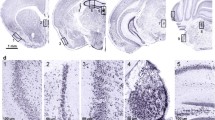Summary
Immunoreactivities of four subtypes of adenylyl cyclase (AC) (types I, II, IV and V/VI), and basal, forskolin- and Mn2+-stimulated AC activities with or without calcium and calmodulin (Ca2+/CaM) were estimated in parietal cortex membranes from cases with dementia of the Alzheimer type (DAT) and age-matched controls. Immunoreactivities of AC-I and AC-II were significantly decreased, but those of AC-IV and AC-V/VI did not change in DAT brains. There was a significant correlation of AC-I immunoreactivity with Ca2+/CaM-sensitive AC activity, but not with the Ca2+/CaM-insensitive activity. Ca2+/CaM-sensitive AC activity was significantly lower in DAT than in the control, indicating that impairment of Ca2+/CaM-sensitive AC-I is clearly involved in the pathophysiology of DAT.
Similar content being viewed by others
References
Bourtchuladze R, Frenguelli B, Blendy J, Cioffi D, Schutz G, Silva AJ (1994) Deficient long-term memory in mice with a targeted mutation of the cAMP-responsive element-binding protein. Cell 79: 59–68
Bradford MM (1976) A rapid and sensitive method for the quantitation of microgram quantities of protein utilizing the principle of protein-dye binding. Anal Biochem 72: 248–254
Chetkovich DM, Sweatt JD (1993) NMDA receptor activation increases cyclic AMP in area CA1 of the hippocampus via calcium/calmodulin stimulation of adenylyl cyclase. J Neurochem 61: 1933–1942
Cowburn RF, O'Neil C, Ravid R, Alafuzoff I, Winblad B, Flowler CJ (1992a) Adenylyl cyclase activity in postmortem human brain: evidence of altered G protein mediation in Alzheimer's disease. J Neurochem 58: 1409–1419
Cowburn RF, O'Neill C, Ravid R, Winblad B, Fowler J (1992b) Preservation of Gi-protein inhibited adenylyl cyclase activity in the brains of patients with Alzheimer's disease. Neurosci Lett 141: 16–20
Feinstem PG, Schrader KA, Bakalyar HA, Tang W-J, Krupinski J, Gilman AG, Reed RR (1991) Molecular cloning and characterization of Ca2+/Calmodulin-insensitive adenylyl cyclase from rat brain. Proc Natl Acad Sci USA 88: 10173–10177
Gsell W, Lange KW, Pfeuffer R, Heckers S, Heinsen H, Senitz D, Jellinger K, Ransmayr G, Wichart I, Vock R, Beckmann H, Riederer P (1993) How to run a brain bank: a report from the Austro-German brain bank. J Neural Transm [Suppl] 39: 31–70
Hummler E, Cole TJ, Blendy JA, Ganss R, Aguzzi A, Schmid W, Beermann F, Schütz G (1994) Targeted mutation of the CREB gene: compensation within the CREB/ATF family of transcription factors. Proc Natl Acad Sci USA 91: 5647–5651
Ikezu T, Okamoto T, Komatsuzaki K (1996) Negative transduction of cAMP response element by familial Alzheimer's mutants of APP. EMBO J 15: 2468–2475
Iyengar R (1993) Molecular and functional diversity of mammalian Gs-stimulated adenylyl cyclase. FASEB J 7: 768–775
Katsushika S, Chen L, Kawabe J, Nilakantan R, Halnon NJ, Homey CJ, Ishikawa Y (1992) Cloning and characterization of a sixth adenylyl isoform: types V and VI constitute a subgroup within the mammalian adenylyl cyclase family. Proc Natl Acad Sci USA 89: 8774–8778
Krupinski J, Coussen F, Bakalyar HA, Tang W-J, Feinstein PG, Orth K, Slaughter C, Reed RR, Gilman AG (1989) Adenylyl cyclase amino acid sequence: possible channel-or transporter-like structure. Science 244: 1558–1564
McKhann G, Drachman D, Folstein M, Katzman R, Price D, Stadlan EM (1984) Clinical diagnosis of Alzheimer's disease: a report of the NINCDS-ADRDA work group under the auspices of the department of health and human services task force on Alzheimer's disease. Neurology 34: 939–944
NcLaughlin M, Ross BM, Milligan G, McCulloch J, Knowler JT (1991) Robustness of G proteins in Alzheimer's disease: an immunoblot study. J Neurochem 57: 9–14
Ohm TG, Bohl J, Lemmer B (1991) Reduced basal and stimulated (isoprenaline, Gpp(NH)p, forskolin) adenylate cyclase activity in Alzheimer's disease correlated with histopathological changes. Brain Res 540: 229–236
Salomon Y (1979) Adenylate cyclase assay. Adv Cycl Nucl Res 10: 35–55
Schnecko A, Witte K, Bohl J, Ohm TG, Lemmer B (1994) Adenylyl cyclase activity in Alzheimer's disease brain: stimulatory and inhibitory signal transduction pathways are differently affected. Brain Res 644: 291–296
Seamon KB, Daly JW (1986) Forskolin: its biological and chemical properties. Adv Cycl Nucl Res 20: 1
Villacres EC, Wu Z, Hua W, Nielsen MD, Watters JJ, Yan C, Beavo J, Storm DR (1995) Developmentally expressed Ca2+-sensitive adenylyl cyclase activity is disrupted in the brains of type I adenylyl cyclase mutant mice. J Biol Chem 270: 14352–14357
Wayman GA, Impey S, Wu Z, Kindsvogel W, Prichard L, Storm DR (1994) Synergisitic activation of the type I adenylyl cyclase by Ca2+ and Gs-coupled receptors in vivo. J Biol Chem 269: 25400–25405
Wu Z, Wong ST, Storm DR (1993) Modification of the calcium and calmodulin sensitivity of the type I adenylyl cyclase by mutagenesis of its calmodulin binding domain. J Biol Chem 268: 23766–23768
Wu Z-L, Thomas SA, Villacres EC, Xia Z, Simmons ML, Chavkin C, Palmiter RD, Storm DR (1995) Altered behavior and long-term potentiation in type I adenylyl cyclase mutant mice. Proc Natl Acad Sci USA 92: 220–224
Xia Z, Choi E-J, Storm DR (1995) Do the calmodulin-stimulated adenylyl cyclases play a role in neuroplasticity? Behav Brain Sci 18: 429–440
Yamamoto M, Ozawa H, Saito T, Frölich L, Riederer P, Takahata N (1996) Reduced immunoreactivity of adenylyl cyclases in dementia of the Alzheimer type. Neuroreport 7: 2965–2970
Yin JCP, Wallach JS, Del Vecchio M, Wilder EL, Zhou H, Quinn WG, Tully T (1994) Induction of a dominant negative CREB transgene specifically blocks long-term memory in Drosophila. Cell 79: 49–58
Author information
Authors and Affiliations
Rights and permissions
About this article
Cite this article
Yamamoto, M., Ozawa, H., Saito, T. et al. Ca2+/CaM-sensitive adenylyl cyclase activity is decreased in the Alzheimer's brain: Possible relation to type I adenylyl cyclase. J. Neural Transmission 104, 721–732 (1997). https://doi.org/10.1007/BF01291889
Received:
Accepted:
Issue Date:
DOI: https://doi.org/10.1007/BF01291889



